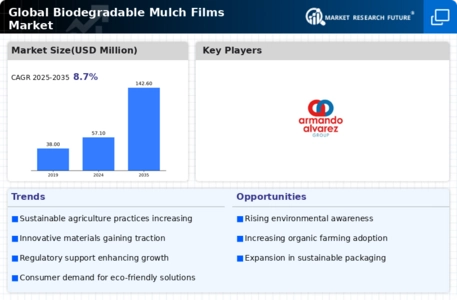Rising Agricultural Production Needs
The rising agricultural production needs due to population growth and food security concerns are propelling the Biodegradable Mulch Films Market. As the global population continues to expand, the demand for food is escalating, prompting farmers to seek innovative solutions to enhance crop yields. Biodegradable mulch films offer several advantages, including improved soil moisture retention and weed control, which can lead to higher productivity. Market forecasts indicate that the agricultural sector will require a 70% increase in food production by 2050, thereby creating a substantial opportunity for biodegradable mulch films. This urgent need for efficient agricultural practices is likely to drive the adoption of biodegradable solutions in the coming years.
Government Initiatives and Incentives
Government initiatives aimed at promoting sustainable agricultural practices are significantly influencing the Biodegradable Mulch Films Market. Various countries have implemented policies that encourage the use of biodegradable materials, including financial incentives for farmers who adopt these practices. For instance, subsidies and grants for the purchase of biodegradable mulch films are becoming more common, thereby enhancing market penetration. Additionally, regulations that restrict the use of conventional plastic products are further propelling the demand for biodegradable alternatives. This supportive regulatory environment is expected to foster innovation and investment in the biodegradable mulch films sector, potentially leading to a more robust market.
Technological Innovations in Production
Technological innovations in the production of biodegradable mulch films are driving advancements within the Biodegradable Mulch Films Market. Recent developments in material science have led to the creation of more efficient and cost-effective biodegradable films, which are increasingly appealing to farmers. Innovations such as the use of biopolymers derived from renewable resources are enhancing the performance characteristics of these films, making them more competitive with traditional options. Market data suggests that the introduction of new production techniques could reduce costs by up to 15%, thereby increasing accessibility for a broader range of agricultural producers. This trend indicates a promising future for the adoption of biodegradable mulch films.
Consumer Preference for Organic Products
The growing consumer preference for organic products is a significant driver for the Biodegradable Mulch Films Market. As consumers become more health-conscious and environmentally aware, the demand for organic produce has surged. This trend compels farmers to adopt sustainable practices, including the use of biodegradable mulch films, to meet consumer expectations. Market analysis reveals that organic farming is projected to grow at a rate of approximately 12% annually, which directly correlates with the increased use of biodegradable materials in agriculture. Consequently, this consumer-driven demand is likely to bolster the market for biodegradable mulch films as producers strive to align with organic standards.
Increasing Awareness of Environmental Issues
The rising awareness of environmental issues among consumers and businesses is a pivotal driver for the Biodegradable Mulch Films Market. As sustainability becomes a priority, stakeholders are increasingly seeking eco-friendly alternatives to traditional plastic mulch films. This shift is evidenced by a growing number of agricultural producers who are adopting biodegradable options to reduce their carbon footprint. Reports indicate that the market for biodegradable products is expected to witness a compound annual growth rate of over 10% in the coming years. This trend suggests that the demand for biodegradable mulch films will likely continue to rise as more entities recognize the importance of sustainable agricultural practices.

















Leave a Comment